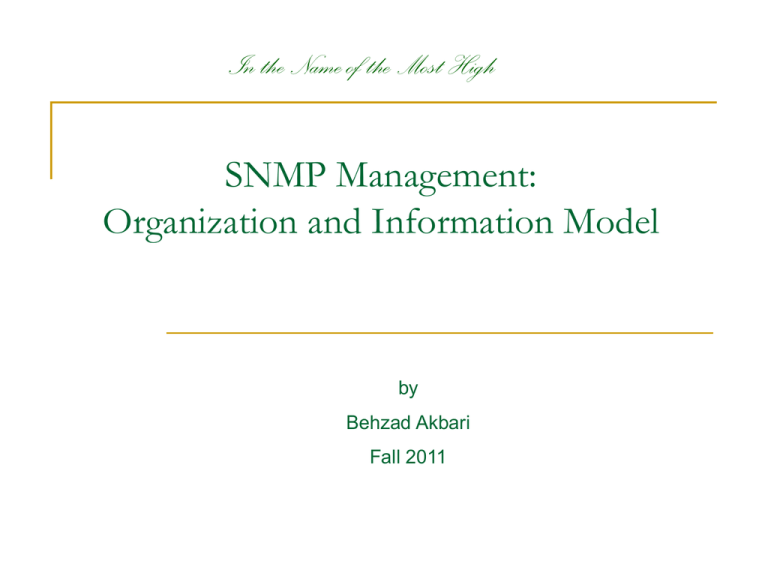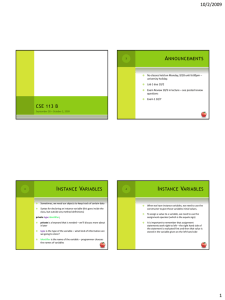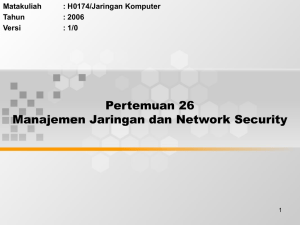SNMP Management_Organization and Information Model.pptx
advertisement

In the Name of the Most High
SNMP Management:
Organization and Information Model
by
Behzad Akbari
Fall 2011
Overview
SNMP is the most widely used network management protocol
When we say SNMP management, we are really referring to Internet management.
SNMP management model:
Organization Model
Relationship between network element, agent, and manager
Hierarchical architecture
Information Model
Uses ASN.1 syntax
SMI (Structure of Management Information
MIB ( Management Information Base)
Communication Model
Transfer syntax
SNMP over TCP/IP
Communication services addressed by messages
Security framework community-based model
Managed LAN
NMS on subnet 192.168.252.1
manages the router and the hubs
on subnet 172.16.46.1 across the
backbone network
Figure 4.1 A Managed LAN Network
Managed Hubs: System Information
Information obtained querying the hubs
Data truly reflects what is stored in the hub
Title: System Information: 172.16.46.2
Name or IP Address: 172.16.46.2
System Name:
System Description: 3Com LinkBuilder FMS, SW version:3.02
System Contact:
System Location:
System Object ID: .iso.org.dod.internet.private.enterprises.43.1.8.5
System Up Time: (2475380437) 286 days, 12:03:24.37
Title: System Information: 172.16.46.3
Name or IP Address: 172.16.46.3
System Name:
System Description: 3Com LinkBuilder FMS, SW version:3.12
System Contact:
System Location:
System Object ID: .iso.org.dod.internet.private.enterprises.43.1.8.5
System Up Time: (3146735182) 364 days, 12:55:51.82
Managed Router: System Information
Title: System Information: router1.gatech.edu
Name or IP Address: 172.16.252.1
System Name: router1.gatech.edu
System Description: Cisco Internetwork Operating System Software
: IOS (tm) 7000 Software (C7000-JS-M), Version
: 11.2(6),RELEASE SOFTWARE (ge1)
: Copyright (c) 1986-1997 by Cisco Systems, Inc.
: Compiled Tue 06-May-97 19:11 by kuong
System Contact:
System Location:
System Object ID:
iso.org.dod.internet.private.enterprises.cisco.ciscoProducts.cisco 7000
System Up Time: (315131795) 36 days, 11:21:57.95
Managed Hub: Port Addresses
Information acquired by the NMS on hub interfaces
Index refers to the interface on the hub
Link address is the MAC address
The second row data is a serial link
Managed Router: Port Addresses
Information acquired by NMS on the router interfaces
Index refers to the interface on the router
LEC is the LAN emulation card
Ethernet 2/0 interface refers to the interface card 2 and port 0 in
that card
Internet Management History
1970s: Advanced Research Project Agency Network
(ARPANET) comes up with Internet control Message Protocol
(ICMP)
Internet Engineering Task Force (IETF)
1990 SNMPv1
1995 SNMPv2
1998 SNMPv3
Internet documents:
Request for Comments (RFC)
IETF STD Internet Standard
FYI For your information
SNMP Related RFCs
Figure 4.4 SNMP Document Evolution
Organization Model
Describes components of a
network management system
Focuses on functions and
infrastructure
Objects are network elements
such as hubs, bridges, routers,
etc.
Managed elements have a
process running on them called
an agent
Manager queries the agent,
gets information, processes it
and stores it in the MIB
MIB
SNMP Manager
agent
agent
Managed Objects
Unmanaged Objects
A simplified hierarchical
(2-tier) setup
Organization Model
Multiple managers, 1 agent
An agent responds to any
management system that
communicates with it using
SNMP
A NMS provided by a
vendor is in a better
position to manage, monitor
and configure all NEs
coming from that same
vendor
MIB
SNMP Manager
SNMP Manager
Managed
agent
Object
Managed Objects
Managers may have restricted
access to managed objects
Organization Model
Limiting the data that a
manager wishes to
obtain!
RMON (Remote
Monitoring): acts as an
agent and a manager
RMON gathers data from
MO, analyses the data, and
stores the data
Communicates the statistics
to the manager
MIB
SNMP Manager
SNMP Manager
Managed
agent
Object
Managed Objects
RMON Probe
Managers may have restricted
access to managed objects
3-tier architecture
Organization Model
Proxy server converts
non-SNMP data from nonSNMP objects to SNMP
compatible objects and
messages
MIB
SNMP Manager
Proxy Server
Managed
agent
Object
Wireless LAN
Managed Objects
unmanaged
Objects
System Overview
SNMP Manager
SNMP messages
SNMP agent
UDP
UDP
IP
IP
DLC
DLC
PHY
PHY
Network
or
Physical
Medium
Internet
Figure 4.9 SNMP Network Management Architecture
Trap
Get-Response
SNMP Agent
Application
Set-Request
Application
Manages objects
Trap
Get-Response
Set-Request
GetNext-Request
Get-Request
SNMP Manager
Application
GetNext-Request
Management
Data
SNMP Agent
Get-Request
SNMP Manager
SNMP System Architecture
Network Elements (NEs)
Management
Station
Host
Router
Manager
Agent
Agent
SNMP
UDP
IP
SNMP
UDP
IP
SNMP
UDP
IP
DL
Network
Management
Protocol
DL
SNMP
Network
...
DL
SNMP Services
Get, Set, GetNext Request
Manager
Get Response
Agent(s)
Trap
Four Services
Get, Set, GetNext, Trap
Five SNMP Messages
GetRequest, SetRequest, GetNextRequest, GetResponse,
Trap
SNMP Services
Get
Get Request
Manager
Get Response
Agent
GetNext Request
GetNext
Manager
Get Response
Agent
Set Request
Set
Trap
Manager
Manager
Get Response
Trap Request
Agent
Agent
SNMP Services (cont.)
Get Request:
Get-Next Request:
Retrieve the values of the next objects in the MIB of an agent.
Set Request:
Retrieve the values of objects in the MIB of an agent.
Update the values of objects in the MIB of an agent.
Trap Request
Report extraordinary events to the manager.
Information Model
• Structure of Management Information (SMI)
(RFC 1155, RFC 1212)
• Managed Object
• Scalar
• Aggregate or tabular object
• Management Information Base (RFC 1213)
Managed Object
Object
Object
Type
Name:
OBJECT
IDENTIFIER
Syntax:
ASN.1
Object
Instance
Encoding:
BER
FigureObject
4.10 Managed
Type Object : Type and Instance
Object Instance
Managed Object: Multiple Instances
Object
Object
Type
Name:
OBJECT
IDENTIFIER
Object
Instance 3
Object
Instance 2
Syntax:
ASN.1
Object Type
Encoding:
BER
Object
Instance 1
Object Instance
Figure 4.11 Managed Object : Type with Multiple Instances
Object Name
• Object is uniquely defined by
• DESCRIPTOR
• OBJECT IDENTIFIER
internet OBJECT IDENTIFIER ::=
{iso org(3) dod(6) 1 }.
internet OBJECT IDENTIFIER ::= {iso(1) standard(3) dod(6) internet(1)}
internet OBJECT IDENTIFIER ::= {1 3 6 1}
internet OBJECT IDENTIFIER ::= {iso standard dod internet }
internet OBJECT IDENTIFIER ::= { iso standard dod(6) internet(1) }
internet OBJECT IDENTIFIER ::= { iso(1) standard(3) 6 1 }
Internet Subnodes
Internet
{1 3 6 1}
directory
(1)
directory
mgmt
(2)
experimental
(3)
private
(4)
OBJECT IDENTIFIER ::= {internet 1}
Figure 4.13 Subnodes under Internet Node in SNMPv1
mgmt
OBJECT IDENTIFIER ::= {internet 2}
experimental
OBJECT IDENTIFIER ::= {internet 3}
private
OBJECT IDENTIFIER ::= {internet 4}
0
ccitt
0
std
1.3.6.1.2.1.2
1
system interface
1
2
mgmt
1
MIB II
at
3
IP
4
2
joint-iso-ccitt
3
org
6
dod
1
internet
3
2
experimental
2
member
body
1
reg
authority
directory
root
1
iso
ICMP TCP
5
6
UDP
7
1.3.6.1.2.1
1.3.6.1.4.1
4
private
1
enterprises
EGP
8
Trans.
10
SNMP
11
Private MIB Example
Internet
{1 3 6 1}
private
(4)
http://www.iana.org/
enterprises
(1)
Enterprise Number
cisco
(9)
hp
(11)
3Com
(43)
Cabletron
(52)
http://www.isi.edu/in-notes/iana/assignments/enterprise-numbers
Figure 4.14 Private Subtree for Commercial Vendors
SNMP ASN.1 Data Type
SNMP ASN.1
Data Type
Tag
Structure
Number
Class
Simple
or
Primitive
Defined
or
Application
Constructor
or
Structured
Universal
Application
Contextspecific
Private
Primitive Data Types
Structure
Primitive types
Data Type
INTEGER
OCTET STRING
OBJECT IDENTIFIER
NULL
Comments
Subtype INTEGER (n1..nN)
Special case: Enumerated
INTEGER type
8-bit bytes binary and textual data
Subtypes can be specified by either
range or fixed
Object position in MIB
Placeholder
• subtype:
• INTEGER (0..255)
• OCTET STRING (SIZE 0..255)
• OCTET STRING (SIZE 8)
Enumerated
• Special case of INTEGER data type
error-status INTEGER {
noError(0),
tooBig(1),
genErr(5),
authorizationError(16)
}
Defined or Application Data Type
Defined types
NetworkAddress Not used
Dotted decimal IP address
IpAddress
Wrap-around, non-negative integer,
Counter
Gauge
TimeTicks
Opaque
monotonically increasing, max 2^32 1
Capped, non-negative integer,
increase or decrease
Non-negative integer in hundredths of
second units
Application-wide arbitrary ASN.1
syntax, double wrapped OCTET
STRING
Constructor or Structured Data Type: SEQUENCE
List Marker
SEQUENCE { <type1>, <type2>,…, <typeN> }
IpAddrEntry ::=
SEQUENCE {
ipAdEntAddr
ipAdEntIfIndex
ipAdEntNetMask
ipAdEntBcastAddr
ipAdEntReasmMaxSize
}
IpAddress,
INTEGER,
IpAddress,
INTEGER,
INTEGER (0..65535)
Constructor or Structured Data Type: SEQUENCE OF
SEQUENCE OF <entry>
where <entry> is a list constructor
ipAddrTable OBJECT-TYPE
SYNTAX SEQUENCE OF IpAddrEntry
ACCESS not-accessible
STATUS mandatory
DESCRIPTION
"The table of addressing information relevant to
this entity's IP addresses."
::= { ip 20 }
Example: IP Address Table
• Each row (table entry) is a sequence: IpAddrEntry.
• The ipAddrTable table is a sequence of rows (entries), i.e.
a sequence of ipAddrEntry.
Encoding
• Basic Encoding Rules (BER)
- Type, Length, and Value (TLV)
Type
Class
(7-8th bits)
Length
P/C
(6th bit)
Value
Tag Number
(1-5th bits)
SNMP Data Types and Tags
Type
Tag
OBJECT IDENTIFIER
SEQUENCE
IpAddress
Counter
Gauge
TimeTicks
Opaque
UNIVERSAL 6
UNIVERSAL 16
APPLICATION 0
APPLICATION 1
APPLICATION 2
APPLICATION 3
APPLICATION 4
Managed Object: Structure
OBJECT:
sysDescr:
Syntax:
Definition:
Access:
Status:
{ system 1 }
OCTET STRING
"A textual description of the entity. This value
should include the full name and version
identification of the system's hardware type,
software operating-system, and networking
software. It is mandatory that this only contain
printable ASCII characters."
read-only
mandatory
Figure 4.17 Specifications for System Description
SMIv1, SMIv2
SMIv1:
SMI
(RFC 1155)
Concise MIB (RFC 1212)
Trap-Type (RFC 1215)
SMIv2:
SMIv2
(RFC 2578)
Textual Conventions (RFC 2579)
Conformance Statements (RFC 2580)
Object-Type Macro (RFC 1155)
OBJECT-TYPE MACRO ::= BEGIN
TYPE NOTATION ::=
"SYNTAX" type (TYPE ObjectSyntax)
“ACCESS" Access
"STATUS" Status
VALUE NOTATION ::= value (VALUE ObjectName)
Access ::= "read-only" | "read-write“ | "write-only
| "not-accessible"
Status ::= "mandatory” | "optional“
END
| "obsolete"
OBJECT-TYPE MACRO (RFC1212)
OBJECT-TYPE MACRO ::=
BEGIN
TYPE NOTATION ::=
"SYNTAX" type(ObjectSyntax)
"ACCESS" Access
"STATUS" Status
DescrPart
ReferPart
IndexPart
DefValPart
VALUE NOTATION ::= value (VALUE ObjectName)
ObjectName ::= OBJECT IDENTIFIER
OBJECT-TYPE Example
sysLocation OBJECT-TYPE
SYNTAX DisplayString (SIZE (0..255))
ACCESS read-write
STATUS mandatory
DESCRIPTION
"The physical location of this node
(e.g.,
`telephone closet, 3rd floor')."
::= { system 6 }
DisplayString ::=
OCTET STRING (SIZE (0..255))
"SYNTAX" type(ObjectSyntax)
ObjectSyntax ::=
CHOICE {
simple
application-wide
}
SimpleSyntax ::=
CHOICE {
number INTEGER,
string
OCTET STRING,
object
OBJECT IDENTIFIER,
empty
NULL
}
SimpleSyntax,
ApplicationSyntax
ApplicationSyntax ::=
CHOICE {
address NetworkAddress,
counter Counter,
gauge
Gauge,
ticks
TimeTicks,
arbitrary Opaque
}
ApplicationSyntax
0 .. 232-1
NetworkAddress ::=
CHOICE {
internet
IpAddress
}
IpAddress ::=
[APPLICATION 0] IMPLICIT OCTET STRING (SIZE (4))
Counter ::=
[APPLICATION 1] IMPLICIT INTEGER (0..4294967295)
Gauge ::=
[APPLICATION 2] IMPLICIT INTEGER (0..4294967295)
TimeTicks ::=
[APPLICATION 3] IMPLICIT INTEGER (0..4294967295)
Opaque ::=
[APPLICATION 4] IMPLICIT OCTET STRING
Back to OBJECT TYPE
"ACCESS" Access "STATUS" Status
Access ::= "read-only"
| "read-write"
| "write-only"
| "not-accessible
Status ::= "mandatory"
| "optional"
| "obsolete"
| "deprecated"
Back to OBJECT TYPE
DescrPart
DescrPart ::=
"DESCRIPTION" value (description DisplayString)
| empty
ReferPart
ReferPart ::=
"REFERENCE" value (reference DisplayString)
| empty
Back to OBJECT TYPE
DefValPart
DefValPart ::=
"DEFVAL" "{" value (defvalue ObjectSyntax) "}"
| empty
Example: ifNumber OBJECT-TYPE
SYNTAX INTEGER
ACCESS read-only
STATUS mandatory
DEFVAL 1
DESCRIPTION
"The number of network interfaces (regardless
of
their current state) present on this system.“
::= { interfaces 1 }
Back to OBJECT TYPE
IndexPart
IndexPart ::=
"INDEX" "{" IndexTypes "}"
IndexTypes ::=
IndexType
| IndexTypes "," IndexType
IndexType ::=
value (indexobject
ObjectName)
| type (indextype)
IndexSyntax ::=
CHOICE {
number
INTEGER (0..MAX),
string
OCTET STRING,
object
OBJECT IDENTIFIER,
address
NetworkAddress,
ipAddress
IpAddress
}
instance-identifier (INDEX)
integer-valued
“IIS Admin” 9.73.73.83.32.65.100.109.105.110
object identifier-valued
1.3.6.1.2 5.1.3.6.1.2
NetworkAddress-valued
‘004096563c2e’H 0.64.150.86.60.46
string-valued, variable-length strings
3
string-valued, fixed-length strings
3
163.22.20.16 1.163.22.20.16
IpAddress-valued
163.22.20.16 163.22.20.16
Index - variable-length string
svSvcTable OBJECT-TYPE
SYNTAX SEQUENCE OF SvSvcEntry
ACCESS not-accessible
STATUS mandatory
DESCRIPTION
"A list of service entries describing
network services installed on this
server.“
::= { server 3 }
svSvcEntry OBJECT-TYPE
SYNTAX SvSvcEntry
ACCESS not-accessible
STATUS mandatory
DESCRIPTION
"The names of the network services
installed on this server."
INDEX { svSvcName }
::= { svSvcTable 1 }
Back to OBJECT TYPE
OBJECT-TYPE Example
dot1dBasePortEntry OBJECT-TYPE
SYNTAX Dot1dBasePortEntry
ACCESS not-accessible
STATUS mandatory
DESCRIPTION
"A list of information for each port of the
bridge."
REFERENCE
"IEEE 802.1D-1990: Section 6.4.2, 6.6.1"
INDEX { dot1dBasePort }
::= { dot1dBasePortTable 1 }
Aggregate Object
• A group of objects
Table of Objects
• Also called tabular objects
• Can be represented by a table with List of Objects
• Columns of objects
• Rows of instances
Objects
Aggregate M.O. Macro: Table Object
ipAddrTable OBJECT-TYPE
SYNTAX SEQUENCE OF IpAddrEntry
ACCESS not-accessible
STATUS mandatory
DESCRIPTION
"The table of addressing information
relevant to this entity's IP addresses."
::= {ip 20}
Aggregate M.O. Macro: Entry Object
ipAddrEntry OBJECT-TYPE
SYNTAX IpAddrEntry
ACCESS not-accessible
STATUS mandatory
DESCRIPTION
"The addressing information for one of
this entity's IP addresses."
INDEX { ipAdEntAddr }
::= { ipAddrTable 1 }
ipAddrEntry: OBJECT-TYPE
IpaddrEntry: SYNTAX
Aggregate M.O. Macro: Entry Object
IpAddrEntry ::=
SEQUENCE {
ipAdEntAddr
IpAddress,
ipAdEntIfIndex
INTEGER,
ipAdEntNetMask
IpAddress,
ipAdEntBcastAddr INTEGER,
ipAdEntReasmMaxSize INTEGER (0..65535)
}
Aggregate M.O. Macro: Columnar Objects
ipAdEntAddr OBJECT-TYPE
SYNTAX IpAddress
ACCESS read-only
STATUS mandatory
DESCRIPTION
"The IP address to which this entry's
addressing information pertains.”
::= { ipAddrEntry 1 }
Tabular Representation of Aggregate Object
TABLE
T
ENTRY
E
COLUMNAR
OBJECT 1
COLUMNAR
OBJECT 2
COLUMNAR
OBJECT 3
COLUMNAR
OBJECT 4
Figure 4.22(a) Multiple Instance Managed Object
COLUMNAR
OBJECT 5
Tabular Representation of Aggregate Object
T
T.E
T.E.1.1
T.E.2.1
T.E.3.1
T.E.4.1
T.E.5.1
T.E.1.2
T.E.2.2
T.E.3.2
T.E.4.2
T.E.5.2
T.E.1.3
T.E.2.3
T.E.3.3
T.E.4.3
T.E.5.3
T.E.1.4
T.E.2.4
T.E.3.4
T.E.4.4
T.E.5.4
Multiple Instances of Aggregate Managed
Object
ipAddrTable {1.3.6.1.2.1.4.20}
ipAddrEntry (1)
ipAdEntAddr (1)
ipAdEntIfIndex (2)
ipAdEntNetMask (3)
ipAdEntBcastAddr (4)
ipAdEntReasmMaxSize (5)
Columnar object ID of ipAdEntBcastAddr is (1.3.6.1.2.1.4.20.1.4):
iso org dod internet mgmt mib ip ipAddrTable ipAddrEntry ipAdEntBcastAddr
1 3 6
1
2 1 4
20
1
4
Figure 4.23(a) Columnar objects under ipAddrEntry
Example
Row
ipAdEntAddr
ipAdEntIfIndex
IpAdEntNetMask
IpAdEntBcastAddr
IpAdEntReasmMaxSize
1
2
3
4
123.45.2.1
123.45.3.4
165.8.9.25
9.96.8.138
1
3
2
4
255.255.255.0
255.255.0.0
255.255.255.0
255.255.255.0
0
1
0
0
12000
12000
10000
15000
Figure 4.23(b) Object instances of ipAddrTable (1.3.6.1.2.1.4.20)
Columnar Object
ipAdEntAddr
1.3.6.1.2.1.4.20.1.1
ipAdEntIfIndex
1.3.6.1.2.1.4.20.1.2
ipAdEntBcastAddr
1.3.6.1.2.1.4.20.1.4
IpAdEntReasmMaxSize
1.3.6.1.2.1.4.20.1.5
Row # in (b)
Object Identifier
2
{1.3.6.1.2.1.4.20.1.1.123.45.3.4}
3
{1.3.6.1.2.1.4.20.1.2.165.8.9.25}
1
{1.3.6.1.2.1.4.20.1.4.123.45.2.1}
4
{1.3.6.1.2.1.4.20.1.5.9.96.8.138}
Figure 4.23(c) Object Id for specific instance
Identification of Managed Objects
Use Object Identifier (OID)
OID = Object Type OID
Object Type OID:
Each Object type has a unique OID
Instance Identifier:
. Instance Identifier
Identify instances of object type
E.g
.mib-2.interface.ifTable.ifEntry.ifDescr.2
Two Kinds of Managed Objects
Type-Specific Objects:
sysDescr OBJECT-TYPE
SYNTAX DisplayString (SIZE(0..255))
::= {system 1}
OID: mib-2.system.1.0
Columnar Objects
OID:
mib-2.interface.ifTable.ifEntry.ifDescr.2
mib-2.interface.ifTable.ifEntry.ifDescr.6
mib-2.interface.ifTable.ifEntry.ifType.2
mib-2.interface.ifTable.ifEntry.ifType.6
Columnar Objects
ifTable OBJECT-TYPE
SYNTAX SEQUENCE OF IfEntry
…
::= { interface 2 }
ifEntry OBJECT-TYPE
SYNTAX IfEntry
…
INDEX {ifIndex }
::= { ifTable 1}
IfEntry ::= SEQUENCE {
ifIndex
INTEGER,
ifDescr
DisplayString,
ifType INTEGER,
…
}
ifDescr OBJECT-TYPE
SYNTAX DisplayString (SIZE(0..255))
ACCESS read-only
STATUS madatory
...
::= {ifEntry 2}
Columnar Objects
.ifTable.ifEntry.1 (1.3.6.1.2.1.2.2.1.1)
.ifTable.ifEntry.2 (1.3.6.1.2.1.2.2.1.2)
.ifTable.ifEntry.3 (1.3.6.1.2.1.2.2.1.3)
ifIndex ifDescr
ifType
...
1
le0
6
...
6
llc0
1
...
7
lo0
24
...
9
le1
6
...
1.3.6.1.2.1.2.2.1.2.6
1.3.6.1.2.1.2.2.1.3.7
Index in MIB II
ifEntry
atEntry
ipAddrEntry
ipRouteEntry
ipNetToMediaEntry
{ifIndex}
{atNetIfIndex, atNetAddress}
{ipAdEntAddr }
{ipRouteDest}
{ipNetToMediaIfIndex,
ipNetToMediaNetAddress}
tcpConnEntry
{tcpConnLocalAddress, tcpConnLocalPort,
tcpConnRemoteAddress, tcpConnRemotePort}
udpEntry
{udpLocalAddress, udpLocalPort}
egpNeighEntry
{egpNeighAddr}
Index Example
To get the state of the TCP connection:
10.10.13.137: 3125 ===> 61.30.91.235: 80
Use snmp_get_req. to get the “tcpConnState”
of the tcpConnTable in MIB II.
tcpConnState ==> 1.3.6.1.2.1.6.13.1.1
1.3.6.1.2.1.6.13.1.1.10.10.13.137.3125.61.30.91.235.80
tcpConnTable
Management Information Base (MIB)
RFC 1213
MIB is a database containing information about
elements to be managed
For SNMP, the MIB is a structured database (tree)
Each resource to be managed is represented by an
object
Each system (e.g., a router) maintains a MIB that
reflects the status of its managed resources
A NMS monitors/controls the resources by
reading/modifying the values of objects in the MIB
MIB, RFC1213
Internet
{1 3 6 1}
Implementation can be done
as needed (e.g., objects
essential for fault or
configuration management
are added)
If a group is implemented by
a vendor, all its components
are implemented (e.g.
OSPF and all its group
objects)
directory
(1)
mgmt
(2)
experimental
(3)
mib-2
(1)
system (1)
interfaces (2)
at (3)
ip (4)
icmp (5)
snmp (11)
transmission (10)
cmot (9)
egp (8)
udp (7)
tcp (6)
<module name>
<imports>
<definitions>
END
private
(4)
DEFINITIONS ::= BEGIN
Internet MIB-II Group
MIB, RFC1213
-- groups in MIB-II
RFC1213-MIB DEFINITIONS ::= BEGIN
IMPORT mgmt, NetworkAddress, IpAddress,
Counter, Gauge, TimeTicks
FROM RFC1155-SMI
OBJECT-TYPE
FROM RFC-1212;
-- This MIB module uses the extended
-- OBJET-TYPE macro as defined in [14];
--
MIB-II (same prefix as MIB-I)
mib-2
OBJECT IDENTIFIER ::= { mgmt 1 }
-- textual conventions
DisplayString ::=
OCTET STRING
-- This data type is used to model textual
-- information taken from the NVT ASCII character
-- set. By convention, objects
-- with this syntax are declared as having
--SIZE (0..255)
system
interfaces
OBJECT IDENTIFIER ::= { mib-2 1}
OBJECT IDENTIFIER ::= { mib-2 2 }
at
OBJECT IDENTIFIER ::= { mib-2 3 }
ip
OBJECT IDENTIFIER ::= { mib-2 4 }
icmp
OBJECT IDENTIFIER ::= { mib-2 5 }
tcp
OBJECT IDENTIFIER ::= { mib-2 6 }
udp
OBJECT IDENTIFIER ::= { mib-2 7 }
egp
OBJECT IDENTIFIER ::= { mib-2 8 }
cmot
OBJECT IDENTIFIER ::= { mib-2 9 }
transmission OBJECT IDENTIFIER ::= {mib-2 10}
PhysAddress ::=
OCTET STRING
-- This data type is used to model media
-- addresses. For many types of media, this will
-- be in a binary representation. For example,
-- an ethernet address would be represented as
-- a string of 6 octets.
snmp
.
.
.
.
END
OBJECT IDENTIFIER ::= { mib-2 11 }
MIB, System Group
-- the System group
-----
Implementation of the System group is
mandatory for all systems. If an agent is not
configured to have a value for any of these
variables, a string of length 0 is returned.
sysDescr OBJECT-TYPE
SYNTAX DisplayString (SIZE (0..255))
ACCESS read-only
STATUS mandatory
DESCRIPTION
the entity. ……."
::= { system 1 }
"A textual description of
system
(mib-2 1)
sysDescr (1)
sysObjectId
(2)
sysUpTime (3)
sysServices (7)
sysLocation (6)
sysName (5)
sysContact (4)
sysObjectID OBJECT-TYPE
sysUpTime OBJECT-TYPE
SYNTAX OBJECT IDENTIFIER
SYNTAX TimeTicks
ACCESS read-only
ACCESS read-only
STATUS mandatory
STATUS mandatory
DESCRIPTION "The vendor's
DESCRIPTION
authoritative identification of the network
"The time (in hundredths of
management subsystem contained in the
a
second)
since
the
network management
entity."
portion of the system was last
::= { system 2 }
reinitialized."
::= { system 3 }
MIB, System Group
Fault monitoring:
By periodically polling each agent for this value; if the current
value is less than the most recent value, then the agent has
been restarted since last poll!
Entity
sysDescr
sysObjectID
sysUpTime
sysContact
sysName
sysLocation
sysServices
OID
system 1
system 2
system 3
system 4
system 5
system 6
system 7
Description (brief)
Textual description
OBJECT IDENTIFIER of the entity
Time (in hundredths of a second since last reset)
Contact person for the node
Administrative name of the system
Physical location of the node
Value designating the layer services provided by the
entity
Programmed by vendor of
objects during
manufacturing time
MIB, Interface Group
interfaces
(mib-2 2)
It specifies the number of
interfaces in a network
component and the
managed objects
associated with each
interface
E.g., Ethernet bridge with
many network interface
cards
Implementation: mandatory
ifNumber
(1)
ifTable
(2)
ifEntry
(1)
ifIndex (1)
ifDescr (2)
ifType (3)
ifMtu (4)
ifSpeed (5)
ifPhysAddress (6)
ifAdminstatus (7)
ifOperStatus (8)
ifLastChange (9)
ifInOctets (10)
ifInUcastPkts (11)
interfaces OBJECT IDENTIFIER ::= { mib-2 2 }
ifSpecific (22)
ifOutQLen (21)
ifOutErrors (20)
ifOutDiscards (19)
ifOutNUcastPkts (18)
ifOutUcastPkts (17)
ifOutOctets (16)
ifUnknownProtos (15)
ifInErrors (14)
ifInDiscards (13)
ifInNUcastPkts (12)
MIB, Interface Group
interfaces
(mib-2 2)
ifNumber OBJECT-TYPE
SYNTAX INTEGER
ifNumber
ifTable
ACCESS read-only
(1)
(2)
STATUS mandatory
DESCRIPTION "The number of network
ifEntry
interfaces (regardless of their current
(1)
state) present on this system."
ifEntry OBJECT-TYPE
::= { interfaces 1 }
SYNTAX IfEntry
ifTable OBJECT-TYPE
ACCESS not-accessible
SYNTAX SEQUENCE OF IfEntry
STATUS mandatory
ACCESS not-accessible
DESCRIPTION "An interface entry
STATUS mandatory
containing objects at the sub-network
layer and below for a particular
DESCRIPTION "A list of interface
interface."
entries. The number of entries is
given by the value of ifNumber."
INDEX
{ ifIndex }
::= { interfaces 2 }
::= { ifTable 1 }
IfEntry ::= SEQUENCE {ifIndex INTEGER, ifDescr DisplayString, ifType INTEGER,
ifMtu INTEGER, ifSpeed Gauge, ifPhysAddress PhysAddress, ifAdminStatus INTEGER,
ifOperStatus INTEGER, ifLastChange TimeTicks, ifInOctets Counter, ……}
MIB, Interface Group
interfaces
(mib-2 2)
Basic information useful for
network management such as
performance monitoring and
fault control
Examples
1)-measuring the queue length
or the total number of octets
into/out of the system-
indicators for detecting
congestion
2)- measuring the traffic rate on
a given interface!
ifInUcastPkts/second,
ifOutUcastPkts/second
Counter data types, always
incrementing!
ifNumber
(1)
ifTable
(2)
ifEntry
(1)
ifIndex (1)
ifDescr (2)
ifType (3)
ifMtu (4)
ifSpeed (5)
ifPhysAddress (6)
ifAdminstatus (7)
ifOperStatus (8)
ifLastChange (9)
ifInOctets (10)
ifInUcastPkts (11)
ifSpecific (22)
ifOutQLen (21)
ifOutErrors (20)
ifOutDiscards (19)
ifOutNUcastPkts (18)
ifOutUcastPkts (17)
ifOutOctets (16)
ifUnknownProtos (15)
ifInErrors (14)
ifInDiscards (13)
ifInNUcastPkts (12)
MIB, IP Group
ip
(mib-2 4)
Contains information relevant
to the implementation and
operation of IP at a node
ipForwarding (1)
Routers periodically execute
routing algorithms and update
routing tables
ipRoutingDiscards (23)
ipDefaultTTL (2)
ipNetToMediaTable (22)
ipInReceives (3)
ipRouteTable (21)
ipInHdrErrors (4)
ipAddrTable (20)
ipInAddrErrors (5)
ipFragCreates (19)
ipFragFails (18)
ipForwDatagrams (6)
IP Address Table contains
table of IP addresses
IP Route Table contains an
entry for each route
IP Network-to-Media Table is
address translation table
mapping IP addresses to
physical addresses
ipInUnknownProtos (7)
ipFragOKs (17)
ipInDiscards (8)
ipReasmFails (16)
ipInDelivers (9)
ipOutRequests(10)
ipOutDiscards (11)
ipReasmOKs (15)
ipReasmReqds (14)
ipReasmTimeout (13)
ipOutNoRoutes (12)
MIB, IP Group
ip
(mib-2 4)
Gateway or router
TTL in IP header
Total # packets
received from interfaces
# of discarded datagrams
due to header errors
ipForwarding (1)
ipRoutingDiscards (23)
ipDefaultTTL (2)
ipNetToMediaTable (22)
ipInReceives (3)
ipRouteTable (21)
ipInHdrErrors (4)
ipAddrTable (20)
ipInAddrErrors (5)
ipFragCreates (19)
ipFragFails (18)
ipForwDatagrams (6)
ipInUnknownProtos (7)
ipFragOKs (17)
ipInDiscards (8)
ipReasmFails (16)
ipInDelivers (9)
ipOutRequests(10)
ipOutDiscards (11)
ipReasmOKs (15)
ipReasmReqds (14)
ipReasmTimeout (13)
ipOutNoRoutes (12)
MIB, IP Group
ipAddrTable
(ip 20)
ipAddrEntry
(ipAddrTable 1)
ipAdEntReasmMaxSize (5)
ipAdEntAddr (1)
ipAdEntBcastAddr (4)
ipAdEntIfIndex (2)
ipAdEntNetMask
(3)
Entity
ipAddrTable
ipAddrEntry
OID
ip 20
IpAddrTable 1
ipAdEntAddr
IpAddrEntry 1
ipAdEntIfIndex
IpAddrEntry 2
ipAdEntNetMask
IpAddrEntry 3
ipAdEntBcastAddr
ipAdEntReasmMaxSize
IpAddrEntry 4
IpAddrEntry 5
Description (brief)
Table of IP addresses
One of the entries in the IP address
table
The IP address to which this entry's
addressing information pertains
Index value of the entry, same as
ifIndex
Subnet mask for the IP address of
the entry
Broadcast address indicator bit
Largest IP datagram that can be
reassembled on this interface
MIB, IP Group
ipRouteTable
(ip 21)
ipRouteEntry
ipRouteTable (1)
Contains information used for
Internet routing
ipRouteTable information is
useful for: configuration
monitoring, controlling the
routing process as well as fault
isolation
Entity
ipRouteTable
ipRouteEntry
ipRouteDest
ipRouteIfIndex
ipRouteMetric1
ipRouteMetric2
ipRouteMetric3
ipRouteMetric4
ipRouteNextHop
ipRouteType
ipRouteProto
OID
ip 21
ipRouteTable 1
ipRouteEntry 1
ipRouteEntry 2
ipRouteEntry 3
ipRouteEntry 4
ipRouteEntry 5
ipRouteEntry 6
ipRouteEntry 7
ipRouteEntry 8
ipRouteEntry 9
ipRouteAge
ipRouteMask
ipRouteEntry 10
ipRouteEntry 11
ipRouteMetric5
ipRouteInfo
ipRouteEntry 12
ipRouteEntry 13
ipRouteDest (1)
ipRouteInfo (13)
ipRouteMetric5
ipRouteIfIndex (2)
(12)
ipRouteMetric1 (3)
ipRouteMask 11)
ipRouteMetric2 (4)
ipRouteAge (10)
ipRouteMetric3 (5)
ipRouteProto (9)
ipRouteMetric4 (6)
ipRouteType (8)
ipRouteNextHop (7)
Description (brief)
IP routing table
Route to a particular destination
Destination IP address of this route
Index of interface, same as ifIndex
Primary routing metric for this route
An alternative routing metric for this route
An alternative routing metric for this route
An alternative routing metric for this route
IP address of the next hop
Type of route
Routing mechanism by which this route was
learned
Number of seconds since routing was last updated
Mask to be logically ANDed with the destination
address before comparing with the ipRouteDest
field
An alternative metric for this route
Reference to MIB definition specific to the routing
protocol
MIB, TCP Group
Contains info. relevant to the implementation/operation of
connection-oriented TCP
Timeout algorithm for retransmission
tcp
(mib-2 6)
tcpOutRsts (15)
tcpRtoAlgorithm (1)
tcpInErrors (14)
tcpRtoMin (2)
tcpConnTable 13)
tcpRtoMax (3)
tcpRetranSegs (12)
tcpMaxConn (4)
tcpOutSegs (11)
tcpActiveOpens (5)
tcpPassiveOpens (6)
tcpInSegs (10)
Minimum value for
tcpAttemptFails (7)
tcpCurrEstab (9)
retransmission timer
tcpEstabResets (8)
# segments
retransmitted
Maximum value for
retransmission timer
Maximum nb of
TCP connections
# segments
received
# segments
sent
MIB, TCP Group
tcpConnTable
(tcp 13)
tcpConnEntry
(1)
tcpConnState (1)
tcpConnLocalAddress (2)
tcpCommRemPort (5)
tcpConnRemAddress(4)
tcpConnLocalPort (3)
Entity
tcpConnTable
tcpconnEntry
OID
tcp 13
TcpConnTable 1
tcpConnState
TcpConnEntry 1
tcpConnLocalAddress TcpConnEntry 2
TcpConnEntry 3
tcpConnLocalPort
tcpConnRemAddress TcpConnEntry 4
TcpConnEntry 5
tcpConnRemPort
Description (brief)
TCP connection table
Information about a particular TCP
connection
State of the TCP connection
Local IP address
Local port number
Remote IP address
Remote port number



